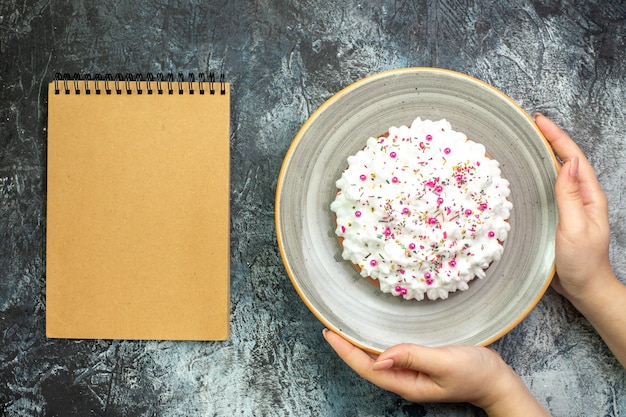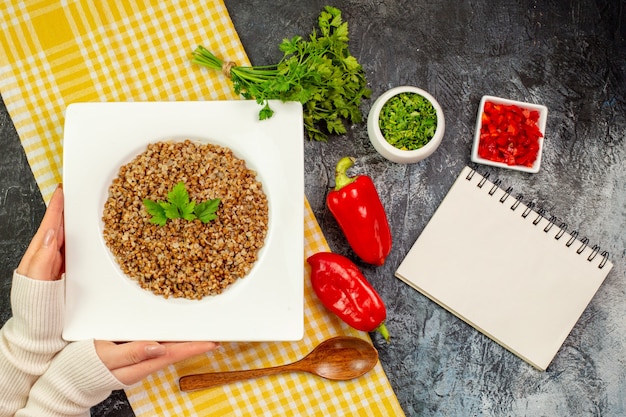Risotto. Just the word conjures up images of creamy, comforting, and oh-so-delicious goodness. But for many, the idea of making it at home can feel daunting. It seems like something you'd only find in fancy restaurants, requiring expert techniques and a whole lot of culinary magic. But believe me, you can make restaurant-quality risotto right in your own kitchen. It's all about understanding a few basic principles, being patient, and having a bit of fun along the way. I've been making risotto for years, and I'm here to share all my tips and tricks, from choosing the right ingredients to mastering the perfect finish. So, grab your apron, gather your ingredients, and get ready to embark on a culinary adventure!
(Part 1) The Foundation: Unveiling the Secrets of Risotto

Let's start with the basics. Risotto isn't just about throwing rice in a pan and calling it a day. It's a method, an art, a delicate dance between rice, stock, and time. And the key to success lies in understanding the essential ingredients and techniques.
The Star of the Show: arborio rice
Forget everything you know about long-grain rice. In the world of risotto, Arborio reigns supreme. This short-grain rice is the heart and soul of the dish, packed with a starchy core that's the secret weapon for that creamy, luxurious texture. When you cook Arborio rice, it releases its starch, creating a luscious sauce that envelops each grain. It's like a little rice miracle, transforming into a silky, decadent masterpiece.
Beyond Arborio: Exploring Other Varieties
While Arborio is the classic choice, you can also explore other varieties like Carnaroli and Vialone Nano. These premium Italian rice types are known for their even higher starch content, resulting in an even creamier risotto. They're a bit more expensive, but the extra luxuriousness is worth the splurge. Think of them as the high-end couture of the risotto world.
The Liquid Lifeline: The Importance of Stock
Imagine a symphony. The rice is the soloist, but the stock is the orchestra, providing the rich, harmonious background that elevates the performance. A good stock is essential for a truly delicious risotto. It's the liquid that infuses flavour into each grain, creating depth and complexity.
I love making my own vegetable stock – a labour of love that yields an incredibly flavorful broth. But don't worry if you're not a stock-making enthusiast, good quality store-bought stock works perfectly. Just avoid those super-concentrated ones that taste more like chemicals than a culinary delight.
Chicken, Vegetable, or Mushroom: Choosing Your Stock
The beauty of risotto is its adaptability. You can use a variety of stocks to create different flavour profiles. Chicken stock adds a classic savoury note, while vegetable stock provides a lighter, more delicate flavour. And for an earthy, umami-rich experience, try mushroom stock. Ultimately, the choice is yours, allowing you to tailor the risotto to your taste preferences.
The Art of "Risottare": The Secret to Creaminess
Now, the name itself holds a clue to the process. Risotto comes from the Italian word "risottare," which means "to re-soak." And that's the key. Instead of adding all the stock at once, you gently cook the rice by adding the stock a little at a time, letting it absorb the liquid before adding more. It's a slow, methodical process, almost meditative, where the magic happens. This is what gives risotto that velvety texture, a creamy embrace that melts in your mouth.
(Part 2) A Beginner's Guide: Mastering the Steps

Now that you've got the foundation laid, it's time to get your hands dirty, literally! Here's a step-by-step guide to making a classic risotto, perfect for beginners or anyone looking to solidify their skills.
Step 1: The Sizzling Start: Sautéing the Foundation
First, warm up a good quality olive oil in a heavy-bottomed pan. I adore using a cast iron pan for this, it distributes heat evenly and adds a rustic charm. But a stainless steel or even a non-stick pan will do just fine. Add a finely chopped onion and a couple of cloves of garlic (optional) to the pan and sauté them until they're soft and fragrant. Don't let them brown, just cook them until they become translucent, releasing their sweet and savory aromas.
Step 2: The Rice Takes Center Stage: Introducing the Arborio
Now, add the Arborio rice to the pan and stir it constantly for about a minute. This is where the magic really begins. The rice will start to toast slightly, releasing its starches and beginning to create that luscious creamy sauce. Keep stirring, don't let the rice stick to the bottom of the pan. You want it to cook evenly, not burn.
Step 3: The Stock Symphony: A Gradual Infusion of Flavor
This is the heart of the risotto process. Start adding your hot stock, one ladleful at a time. Stir constantly, letting the rice absorb the liquid completely before adding more. It's a slow, deliberate process, a rhythmic dance between rice and stock. You can't rush this part. The rice needs time to absorb the flavour and release its starch. I usually start with about a cup of stock and add more as it's absorbed. It's a bit like listening to a symphony, enjoying each subtle change in volume and texture.
Step 4: The Creamy Finish: A Touch of Luxury
After about 15 minutes or so, the rice should be cooked through but still have a slight bite to it. This is the moment we've been waiting for, the grand finale of our risotto journey. Add a generous knob of cold butter to the pan, along with some grated Parmesan cheese (optional). Stir it in until it's melted and the risotto is creamy and glossy. You can also add a splash of white wine to the risotto at this point, it adds a beautiful depth of flavour. A dry white wine like Sauvignon Blanc or Pinot Grigio will really complement the dish.
(Part 3) Flavour Variations: Unleashing your Creativity

The classic risotto is a delightful foundation, but don't let it limit you! Risotto is a blank canvas, waiting for your culinary creativity to paint it with flavour. Here are a few ideas to inspire your next risotto adventure.
Mushroom Risotto: Earthy Delights
One of my personal favourites, mushroom risotto is a symphony of earthy flavours. You can use any kind of mushroom you like, but porcini mushrooms, with their rich, woodsy aroma, are a true treat. Sauté them in the pan with the onion and garlic, then add your rice and proceed as usual. For an extra punch of mushroom flavour, you can even add a spoonful of mushroom stock. It's a creamy, comforting dish that will transport you to a forest clearing.
Seafood Risotto: A Taste of the Sea
For a taste of the ocean's bounty, try a seafood risotto. Add some chopped mussels, clams, or prawns to the pan with the rice. You can also use a seafood stock for a deeper, more marine flavour. It's a delightful way to bring the beach to your kitchen table.
Vegetable Risotto: A Rainbow of Flavors
Risotto is a blank canvas for vegetables, offering endless possibilities for culinary exploration. Add roasted peppers, zucchini, sweet peas, asparagus, or any other seasonal favourites. Just remember to cook the vegetables separately before adding them to the rice, as they have different cooking times.
Herbs and Spices: A Touch of Magic
A pinch of herbs or spices can transform a risotto into a masterpiece. I love to add a pinch of saffron, for its vibrant colour and unique, earthy aroma. You can also use fresh herbs like parsley, basil, or thyme, or add a dash of chilli flakes for a touch of heat. A few drops of lemon juice can brighten up the flavours, adding a touch of zing. Just remember, a little goes a long way.
(Part 4) The Art of Timing: Mastering the Process
Now, you might be thinking, "How do I know when the rice is cooked?" There's no magic formula, but there are a few things to watch for. Remember, risotto is all about texture. It's not about making the rice super soft and mushy. It should have a slight bite to it, a creamy core with a little bit of resistance.
The "Al Dente" Test
The best way to test for "al dente" is to take a single grain of rice between your thumb and finger. It should be cooked through but still have a slight resistance, like a firm chew. It shouldn't be hard or crunchy, just slightly firm, indicating that the starch has been released but the rice still has some structure.
The "Spoon Test"
You can also use a spoon to check the consistency. Scoop some risotto onto the back of a spoon. It should coat the spoon smoothly, without being too watery or too thick. It should hold its shape slightly, but also have a lovely creamy texture.
The Timing Game
How long it takes to cook a risotto depends on the rice you're using, the amount of stock you're adding, and the heat of your stove. Generally, it takes around 15-20 minutes. Don't worry if it takes a little longer, just keep adding stock and stirring. The key is to be patient and not rush the process.
(Part 5) Risotto Troubleshooting: Navigating the Common Mistakes
Even the most experienced cooks have their risotto disasters. But don't fret, there's a solution for every risotto mishap! Here are a few common mistakes and how to fix them.
The "Sticky Situation"
Letting the rice stick to the bottom of the pan is one of the most common risotto woes. It happens if you're not stirring constantly. If this happens, just add a little extra stock and stir vigorously. It should loosen up, but if it's a real disaster, you can scrape the sticky rice off the bottom and start again.
The "Watery Mess"
If your risotto is too watery, you need to reduce the liquid. Just keep cooking it on low heat, stirring occasionally, until it reaches the desired consistency. You can also add a little more butter or cheese to thicken it up.
The "Lumpy Nightmare"
Lumpy risotto is a common issue, and it usually happens if you add the stock too quickly or don't stir enough. If you find yourself with a lumpy risotto, try to break up the lumps with a whisk. You can also add a little more stock and stir gently to smooth it out.
(Part 6) Presentation: Turning Risotto into Art
We've got the perfect risotto, but how do we present it? You want to show off all that hard work and make it look as delicious as it tastes.
The Simple Elegance of a Bowl
A simple white bowl is the perfect backdrop for risotto. It lets the creamy texture and vibrant colours shine.
A Garnish to Enhance
A simple garnish can really elevate your risotto. A sprig of fresh parsley, a few shavings of Parmesan cheese, or a drizzle of olive oil can add a touch of elegance.
The Art of Texture
You can also play with texture. A sprinkle of chopped nuts, a dollop of cream, or some toasted bread crumbs can add a contrasting crunch.
(Part 7) Risotto Beyond the Plate: A Culinary Adventure
Risotto isn't just a dinner dish, it's a versatile ingredient that can be used in all sorts of ways. Here are a few ideas to get your creative juices flowing:
Risotto Balls: A Crispy Delight
Turn your leftover risotto into delicious risotto balls. Just shape the risotto into balls, coat them in breadcrumbs, and deep-fry or bake them until golden brown. They're perfect as a starter or a snack.
Risotto Arancini: A Sicilian Favourite
Risotto arancini are a classic Italian street food. They're similar to risotto balls, but often filled with cheese or other fillings. You can find them in many Italian restaurants and markets.
Risotto Soup: A Warm and Comforting Treat
Add some broth to your leftover risotto and you have a hearty and delicious soup. You can add vegetables, meat, or cheese to make it even more satisfying.
(Part 8) FAQs: Your Risotto Queries Answered
You've got questions, I've got answers! Here's a roundup of some common risotto questions and my advice.
1. Can I make risotto in advance?
Risotto is best enjoyed fresh, but you can make it a few hours ahead of time. Just reheat it gently in a pan with a little extra stock, stirring occasionally. Don't overcook it or it will become mushy.
2. What happens if I add too much stock?
If you add too much stock, your risotto will be watery. Just keep cooking it on low heat, stirring occasionally, until it reaches the desired consistency. You can also add a little more butter or cheese to thicken it up.
3. Can I use a different type of rice?
Arborio rice is the best choice for risotto, but you can also use Carnaroli or Vialone Nano. Avoid using long-grain rice, as it won't have the same creamy texture.
4. Can I use a pressure cooker?
You can technically make risotto in a pressure cooker, but it won't have the same texture as traditional risotto. The pressure cooker will cook the rice too quickly and it won't have time to absorb all the liquid and release its starches.
5. How long can I keep leftover risotto?
Leftover risotto can be kept in the refrigerator for up to 3 days. It's best to reheat it gently in a pan with a little extra stock. You can also use it in other dishes, like risotto balls or soup.
And there you have it, a complete guide to mastering the art of creamy risotto. Now, go forth and make some risotto magic! And remember, the key is to relax, enjoy the process, and don't be afraid to experiment with flavours. Happy cooking!
Everyone is watching

How to Cook Frozen Lobster Tails Perfectly: A Step-by-Step Guide
RecipesLobster. Just the word conjures up images of lavish meals, special occasions, and a taste of luxury. But let's...

Pigs in a Blanket Cooking Time: How Long to Bake for Perfect Results
RecipesAh, pigs in a blanket. Just the name conjures up images of those delightful little parcels of crispy pastry en...

Pork Fillet Cooking Time: How Long to Cook It Perfectly
RecipesPork fillet, or tenderloin as it's sometimes called, is a real favourite in our house. It's so versatile, and...

The Ultimate Guide to Cooking Delicious Frankfurters
RecipesLet's face it, we all love a good frankfurter. It's a classic, simple, and always satisfying. But let's be rea...

Wolf Meat Recipes: A Guide to Cooking Wild Game
RecipesLet's be honest, you don't see wolf meat at your local butcher shop every day. It's a bit of a wild card, but ...
